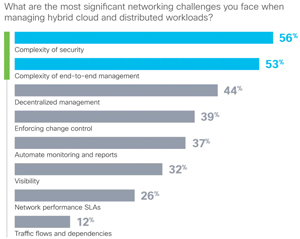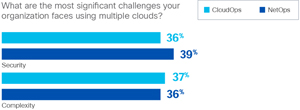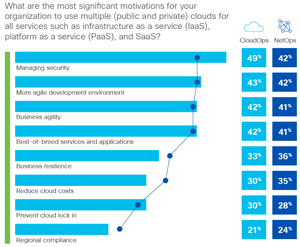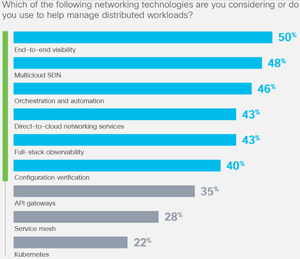News
Cisco Report: Multicloud-Enabled Networks Key to 'Viable Future'
Examining "new rules for a multicloud world," Cisco published a survey-based networking trends report that relates the very future of organizations to multicloud-enabled networks.
The Nov. 15 "2023 Global Networking Trends Report" further finds multicloud software-defined networking (SDN) is highly coveted tech, while management complexity is approaching ever-present security concerns as a top challenge when managing distributed and hybrid workloads.
The report is primarily based on a survey of more than 2,500 global IT pros, especially targeting early adopters and thought leaders in cloud/development/network operations in an attempt to be as forward-looking as possible, the company said.
In looking forward, the report seems to indicate the ability to connect multicloud implementations is actually an existential concern for enterprises.
"If a company is to have a viable future, the network needs to be multicloud-enabled, ubiquitous, reliable, secure, and agile," the report's introduction said.
The most significant challenge to securing a viable future, of course, is security -- always security -- mentioned by 56 percent of respondents. However, while "complexity of security" was the No. 1 response when listing networking challenges faced when managing hybrid cloud and distributed workloads, "complexity of end-to-end management" was close behind, named by 53 percent of respondents.
 [Click on image for larger view.] Networking Challenges (source: Cisco).
[Click on image for larger view.] Networking Challenges (source: Cisco).
The survey also separately asked CloudOps and NetOps pros about the most significant challenges their organizations face when using multiple clouds, and the results were similar to above. Specifically, security was mentioned by 36 percent of respondents in the CloudOps space and 39 percent of NetOps respondents as the top challenge, while complexity was close behind, identified by 37 percent of CloudOps team members and 36 percent of NetOps folks.
 [Click on image for larger view.] Multiple Cloud Challenges (source: Cisco).
[Click on image for larger view.] Multiple Cloud Challenges (source: Cisco).
With the rise of complexity becoming a more significant concern, a related "expert guidance" snippet of advice was included in the report. "Complexity is a function of the decentralized nature of the network, clouds, and internet," said a company exec. "But as both security and management get spread over a wider and more complex landscape, it simply isn't possible to manage everything manually. Adding more technologies to the mix won't necessarily help; solutions must be the right ones. Adopting a platforms approach will allow organizations to automate management and visibility, simplify their ever-growing complex networks, and deliver a unified experience from end to end.
"Platforms powered by AI and machine learning can support an effective cloud operating model that automates end-to-end policy for network and cloud management across different teams. By building more intelligence into common platforms, the network can work harder and take more of the administrative load. That means IT can spend more time focusing on the business experience and outcomes, where it's needed most."
Security -- specifically the management of same -- was also the most significant motivation for organizations to use multiple (public and private) clouds for all services. Here, managing security was the No. 1 response from CloudOps (49 percent), while in NetOps it was tied with "more agile development environment," both garnering 42 percent of responses.
 [Click on image for larger view.] Multiple Cloud Motivations (source: Cisco).
[Click on image for larger view.] Multiple Cloud Motivations (source: Cisco).
Regarding that last data point, the report said it marked a milestone change in Cisco's continuing series of reports (for example, the company has published similar reports for at least the past two years, and the new survey report is closely related to a "2022 Global Hybrid Cloud Trends Report" published in May and covered in the Virtualization & Cloud Review article, "Cisco Describes Hybrid Cloud 'New Normal,' Touts Cloud Operating Model for Success"). "For the first time, agility and business performance have overtaken cost and network management as the key concerns for IT teams, with 42 percent of respondents citing a more agile development environment as their top reason for moving to multiple clouds," today's report said.
Another key takeaway concerns technology priorities, finding that the most-wanted tools offer visibility and automation, with the infamous "complexity" concern again in the mix.
"The complexity that has become such a challenge for hybrid cloud networking is having a clear impact on technology choices," Cisco said. "Visibility is a recurring theme in much of our survey, and it represents two of the top five responses for network technology considerations. End-to-end visibility (50 percent) and full-stack observability (43 percent) are especially important in complex multicloud and cloud-native environments for ensuring the health of application performance and user experience.
 [Click on image for larger view.] Technology Priorities/Most-Wanted Tools (source: Cisco).
[Click on image for larger view.] Technology Priorities/Most-Wanted Tools (source: Cisco).
"Because of their ability to simplify complex operations, orchestration and automation rank in the top three of such technologies. Software-defined networking (SDN) can also provide network consistency and enjoys a similar role in the hybrid cloud. Interestingly, direct-to-cloud networking, which delivers faster middle-mile conduits to cloud providers, is one of the top networking technologies businesses are embracing for hybrid cloud networking."
Other data points of the report include:
- Although cloud adoption continues apace, 50 percent of respondents say that most of their workloads are still deployed on-premises.
- "Faster problem resolution" was the No. 1 feature or benefit of hybrid cloud networking most in demand, named by 50 percent of respondents and followed by "faster provisioning/change" (48 percent) and "proactive problem detection" (48 percent).
- When asked about top difficulties of deploying networks that support cloud native, the top answers were: "secure traffic through microservices" (34 percent); "self-service provisioning and change management" (32 percent); and "automating network workflows" (32 percent).
- "Improved cloud security" was listed by 45 percent of respondents who were asked about key motivations for greater networking/cloud collaboration, followed by "overall greater efficiency" (41 percent) and "enhanced cloud app performance" (39 percent).
- When asked to list the top three roadblocks preventing more collaboration between teams, the top answers were: "competing priorities" (55.4 percent); "shortage of skilled staff" (41.5 percent); and "lack of cross-domain telemetry" (41.5 percent).
"The trends in this report provide fresh insights that can help guide your network and cloud decisions over the next five years," Cisco said in conclusion. "In themselves, many of the ideas aren't new: themes such as cross-functional collaboration, increased complexity, and business-driven network operations have been part of the conversation for several years. What is different this time around is that these issues are now having a real impact on day-to-day operations for technology leaders.
"The last two years of uncertainty meant that network operations had to quickly adopt a model that could support increased network and business agility, better security, and improved application performance. This tipped the balance in favor of processes and objectives that many organizations planned to implement someday and made that day today."
About the Author
David Ramel is an editor and writer at Converge 360.